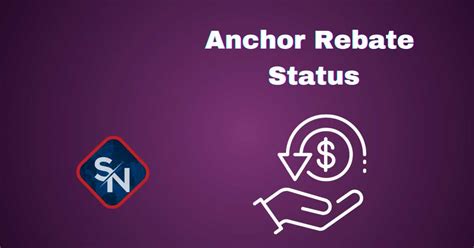Navigating the Waves: Current Status of the Anchor Rebate Explained
The Anchor Rebate program has been a significant development in the financial landscape, particularly for homeowners and investors in the real estate market. With fluctuations in government policies and economic conditions, keeping abreast of the current status of this rebate can alleviate confusion and provide clarity for potential beneficiaries. In this article, we will explore the definitions, benefits, current developments, eligibility requirements, and ramifications surrounding the Anchor Rebate program.
What is the Anchor Rebate?
The Anchor Rebate is a financial incentive aimed at providing relief to homeowners facing high property taxes. This program is designed to ensure that property taxes remain manageable and affordable for average families, providing them with a rebate based on their property taxes paid in a given tax year. The rationale behind the rebate is to promote financial stability among homeowners and ensure that communities can thrive without the burden of excessive taxation.
Benefits of the Anchor Rebate
- Financial Relief: Homeowners can receive a substantial rebate that directly reduces their overall tax burden.
- Encouragement for Homeownership: By alleviating tax pressures, the program encourages individuals and families to invest in real estate, fostering community growth and stability.
- Increased Accessibility: The easing of property taxes can make it easier for first-time buyers to enter the market.
Current Status of the Anchor Rebate Program
As of 2023, the Anchor Rebate program has seen some significant updates. Firestorms of debate and discussion have surrounded the program due to the constantly changing landscape of tax regulations and economic conditions. Recently, government officials have taken steps to enhance and streamline the application process, making it more accessible for eligible homeowners.
Key Developments:
- Extended Eligibility: The government has extended the eligibility criteria to include more homeowners, encompassing those in lower income brackets who previously struggled with property taxes.
- Increased Funding: Recent budgets have allocated more funding for the program, allowing for larger rebates to homeowners.
- Revised Application Process: Officials have simplified the application process to make it less intimidating and time-consuming, which should encourage more individuals to apply.
Eligibility Requirements
To qualify for the Anchor Rebate, homeowners must meet specific criteria that typically include:
- Property ownership in the state or region where the rebate is offered
- Meeting specific income limits, which vary based on local regulations
- Filing taxes annually and providing proof of property tax payments
- Being a primary residence, as investment properties may not be eligible
How to Apply for the Anchor Rebate
The application process for the Anchor Rebate has been streamlined significantly. Here’s a step-by-step guide:
- Gather Documentation: Collect necessary documents, such as property tax bills and income proof.
- Check Eligibility: Review local guidelines to ensure that you meet all eligibility criteria.
- Fill Out Application: Complete the application form, which is often available online or at local government offices.
- Submit the Application: Submit your application before the deadline, ensuring all documentation is included.
- Track Application Status: After submission, keep track of your application status to ensure timely processing.
Potential Ramifications of the Anchor Rebate
While the Anchor Rebate program presents numerous advantages, it also carries certain implications:
- Budget Strains: Increased funding in the program can create budget strains on local governments, impacting other community services.
- Real Estate Market Impact: The rebate may stimulate property prices, potentially making it harder for low-income families to enter the housing market.
- Ongoing Adjustments: The program will likely continue to evolve based on economic conditions, necessitating regular review and adjustments to the eligibility and funding processes.
Conclusion
The Anchor Rebate program stands out as a vital initiative aimed at alleviating the financial burden of property taxes for many homeowners. Its recent developments have made it more accessible, with extended eligibility and increased funding. However, potential applicants should be mindful of their unique situations and the ongoing changes that may impact the program. By staying informed and understanding the nuances of the rebate, homeowners can navigate these financial waters with confidence.
FAQs
1. How much can I expect to receive from the Anchor Rebate?
The amount varies based on your property taxes and local guidelines. Check with your local government for specific figures.
2. Can renters apply for the Anchor Rebate?
No, the Anchor Rebate is typically only available to homeowners who pay property taxes on their primary residences.
3. What happens if my application is denied?
If your application is denied, you should receive an explanation. You may have the option to appeal the decision based on additional eligibility documentation.
4. When is the application deadline for the Anchor Rebate?
The deadline can vary by region. It’s essential to check with your local government to ascertain the specific deadline for your area.
5. Is the Anchor Rebate taxable?
The Anchor Rebate is generally not considered taxable income, but it’s advisable to consult a tax professional for guidance specific to your situation.
This HTML format article covers the status and details about the Anchor Rebate while providing readers with relevant insights, a discussion on potential ramifications, a conclusion, and a FAQs section for additional clarity.
Download Status Of Anchor Rebate
